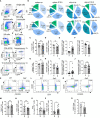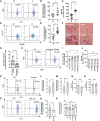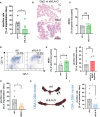Human Leucocyte Antigen G and Murine Qa-2 Are Critical for Myeloid Derived Suppressor Cell Expansion and Activation and for Successful Pregnancy Outcome
- PMID: 35111157
- PMCID: PMC8801456
- DOI: 10.3389/fimmu.2021.787468
Human Leucocyte Antigen G and Murine Qa-2 Are Critical for Myeloid Derived Suppressor Cell Expansion and Activation and for Successful Pregnancy Outcome
Abstract
During pregnancy, maternal immune system has to balance tightly between protection against pathogens and tolerance towards a semi-allogeneic organism. Dysfunction of this immune adaptation can lead to severe complications such as pregnancy loss, preeclampsia or fetal growth restriction. In the present study we analyzed the impact of the murine MHC class Ib molecule Qa-2 on pregnancy outcome in vivo. We demonstrate that lack of Qa-2 led to intrauterine growth restriction and increased abortion rates especially in late pregnancy accompanied by a disturbed trophoblast invasion and altered spiral artery remodeling as well as protein aggregation in trophoblast cells indicating a preeclampsia-like phenotype. Furthermore, lack of Qa-2 caused imbalanced immunological adaptation to pregnancy with altered immune cell and especially T-cell homeostasis, reduced Treg numbers and decreased accumulation and functional activation of myeloid-derived suppressor cells. Lastly, we show that application of sHLA-G reduced abortion rates in Qa-2 deficient mice by inducing MDSC. Our results highlight the importance of an interaction between HLA-G and MDSC for pregnancy success and the therapeutic potential of HLA-G for treatment of immunological pregnancy complications.
Keywords: HLA-G; Qa-2; abortion; myeloid-derived suppressor cells; preeclampsia; pregnancy.
Copyright © 2022 Dietz, Schwarz, Velic, González-Menéndez, Quintanilla-Martinez, Casadei, Marmé, Poets, Gille and Köstlin-Gille.
Conflict of interest statement
The authors declare that the research was conducted in the absence of any commercial or financial relationships that could be construed as a potential conflict of interest.
Figures





Similar articles
-
HLA-G promotes myeloid-derived suppressor cell accumulation and suppressive activity during human pregnancy through engagement of the receptor ILT4.Eur J Immunol. 2017 Feb;47(2):374-384. doi: 10.1002/eji.201646564. Epub 2016 Dec 9. Eur J Immunol. 2017. PMID: 27859042
-
HIF-1α-Deficiency in Myeloid Cells Leads to a Disturbed Accumulation of Myeloid Derived Suppressor Cells (MDSC) During Pregnancy and to an Increased Abortion Rate in Mice.Front Immunol. 2019 Feb 5;10:161. doi: 10.3389/fimmu.2019.00161. eCollection 2019. Front Immunol. 2019. PMID: 30804946 Free PMC article.
-
Myeloid-derived suppressor cells are essential for maintaining feto-maternal immunotolerance via STAT3 signaling in mice.J Leukoc Biol. 2016 Sep;100(3):499-511. doi: 10.1189/jlb.1A1015-481RR. Epub 2016 Feb 26. J Leukoc Biol. 2016. PMID: 27203698
-
New Insights Into the Role of Qa-2 and HLA-G Non-classical MHC-I Complexes in Malignancy.Front Immunol. 2018 Dec 6;9:2894. doi: 10.3389/fimmu.2018.02894. eCollection 2018. Front Immunol. 2018. PMID: 30574154 Free PMC article. Review.
-
Roles of HLA-G in the Maternal-Fetal Immune Microenvironment.Front Immunol. 2020 Oct 22;11:592010. doi: 10.3389/fimmu.2020.592010. eCollection 2020. Front Immunol. 2020. PMID: 33193435 Free PMC article. Review.
Cited by
-
Depletion of Ly6G-Expressing Neutrophilic Cells Leads to Altered Peripheral T-Cell Homeostasis and Thymic Development in Neonatal Mice.Int J Mol Sci. 2023 Apr 24;24(9):7763. doi: 10.3390/ijms24097763. Int J Mol Sci. 2023. PMID: 37175470 Free PMC article.
-
Here, There, and Everywhere: Myeloid-Derived Suppressor Cells in Immunology.J Immunol. 2023 May 1;210(9):1183-1197. doi: 10.4049/jimmunol.2200914. J Immunol. 2023. PMID: 37068300 Free PMC article. Review.
-
Impact of the adenosine receptor A2BR expressed on myeloid cells on immune regulation during pregnancy.Eur J Immunol. 2024 Dec;54(12):e2451149. doi: 10.1002/eji.202451149. Epub 2024 Oct 25. Eur J Immunol. 2024. PMID: 39460389 Free PMC article.
-
An evolved AAV variant enables efficient genetic engineering of murine T cells.Cell. 2023 Jan 19;186(2):446-460.e19. doi: 10.1016/j.cell.2022.12.022. Epub 2023 Jan 12. Cell. 2023. PMID: 36638795 Free PMC article.
References
Publication types
MeSH terms
Substances
LinkOut - more resources
Full Text Sources
Molecular Biology Databases
Research Materials

